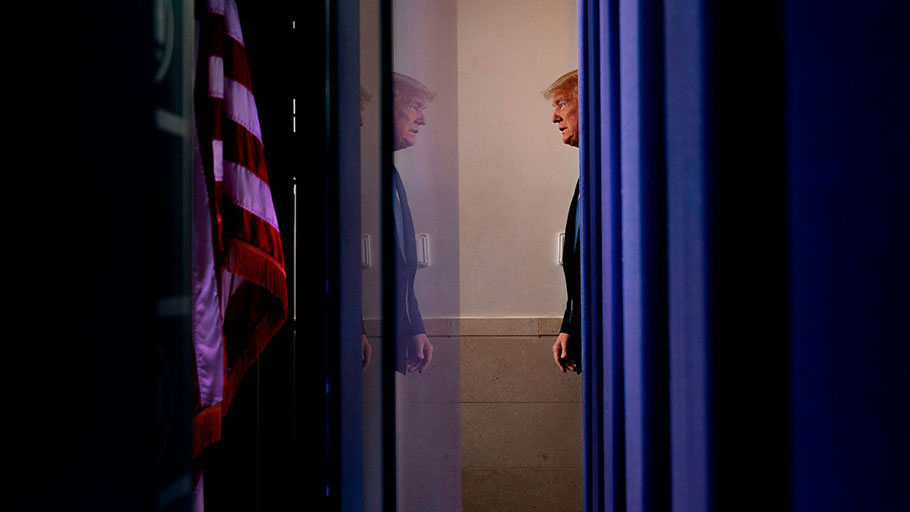Donald Trump arrives to speak the daily coronavirus briefing at the White House last Saturday. Photograph: Jim Watson/AFP via Getty Images
The president was aware of the danger from the coronavirus – but a lack of leadership has created an emergency of epic proportions.
By Ed Pilkington and Tom McCarthy, The Guardian —
When the definitive history of the coronavirus pandemic is written, the date 20 January 2020 is certain to feature prominently. It was on that day that a 35-year-old man in Washington state, recently returned from visiting family in Wuhan in China, became the first person in the US to be diagnosed with the virus.
On the very same day, 5,000 miles away in Asia, the first confirmed case of Covid-19 was reported in South Korea. The confluence was striking, but there the similarities ended.
In the two months since that fateful day, the responses to coronavirus displayed by the US and South Korea have been polar opposites.
One country acted swiftly and aggressively to detect and isolate the virus, and by doing so has largely contained the crisis. The other country dithered and procrastinated, became mired in chaos and confusion, was distracted by the individual whims of its leader, and is now confronted by a health emergency of daunting proportions.
Within a week of its first confirmed case, South Korea’s disease control agency had summoned 20 private companies to the medical equivalent of a war-planning summit and told them to develop a test for the virus at lightning speed. A week after that, the first diagnostic test was approved and went into battle, identifying infected individuals who could then be quarantined to halt the advance of the disease.

A nurse at testing booth outside the Yangji hospital in Seoul. Photograph: Ed Jones/AFP via Getty Images
Some 357,896 tests later, the country has more or less won the coronavirus war. On Friday only 91 new cases were reported in a country of more than 50 million.
The US response tells a different story. Two days after the first diagnosis in Washington state, Donald Trump went on air on CNBC and bragged: “We have it totally under control. It’s one person coming from China. It’s going to be just fine.”
‘A fiasco of incredible proportions’
A week after that, the Wall Street Journal published an opinion article by two former top health policy officials within the Trump administration under the headline Act Now to Prevent an American Epidemic. Luciana Borio and Scott Gottlieb laid out a menu of what had to be done instantly to avert a massive health disaster.
Top of their to-do list: work with private industry to develop an “easy-to-use, rapid diagnostic test” – in other words, just what South Korea was doing.
It was not until 29 February, more than a month after the Journal article and almost six weeks after the first case of coronavirus was confirmed in the country that the Trump administration put that advice into practice. Laboratories and hospitals would finally be allowed to conduct their own Covid-19 tests to speed up the process.
Today, 86,012 cases have been confirmed in the US, pushing the nation to the top of the world’s coronavirus league table
Those missing four to six weeks are likely to go down in the definitive history as a cautionary tale of the potentially devastating consequences of failed political leadership. Today, 86,012 cases have been confirmed across the US, pushing the nation to the top of the world’s coronavirus league table – above even China.
More than a quarter of those cases are in New York City, now a global center of the coronavirus pandemic, with New Orleans also raising alarm. Nationally, 1,301 people have died.
Most worryingly, the curve of cases continues to rise precipitously, with no sign of the plateau that has spared South Korea.
“The US response will be studied for generations as a textbook example of a disastrous, failed effort,” Ron Klain, who spearheaded the fight against Ebola in 2014, told a Georgetown university panel recently. “What’s happened in Washington has been a fiasco of incredible proportions.”

An empty Times Square. New York is now considered a global center of the pandemic. Photograph: Jeenah Moon/Reuters
Jeremy Konyndyk, who led the US government’s response to international disasters at USAid from 2013 to 2017, frames the past six weeks in strikingly similar terms. He told the Guardian: “We are witnessing in the United States one of the greatest failures of basic governance and basic leadership in modern times.”
In Konyndyk’s analysis, the White House had all the information it needed by the end of January to act decisively. Instead, Trump repeatedly played down the severity of the threat, blaming China for what he called the “Chinese virus” and insisting falsely that his partial travel bans on China and Europe were all it would take to contain the crisis.
‘The CDC was caught flat-footed’
If Trump’s travel ban did nothing else, it staved off to some degree the advent of the virus in the US, buying a little time. Which makes the lack of decisive action all the more curious.
“We didn’t use that time optimally, especially in the case of testing,” said William Schaffner, an infectious diseases specialist at Vanderbilt University medical center. “We have been playing reluctant catch-up throughout.”
As Schaffner sees it, the stuttering provision of mass testing “put us behind the eight-ball” right at the start. “It did not permit us, and still doesn’t permit us, to define the extent of the virus in this country.”
Though the decision to allow private and state labs to provide testing has increased the flow of test kits, the US remains starkly behind South Korea, which has conducted more than five times as many tests per capita. That makes predicting where the next hotspot will pop up after New York and New Orleans almost impossible.
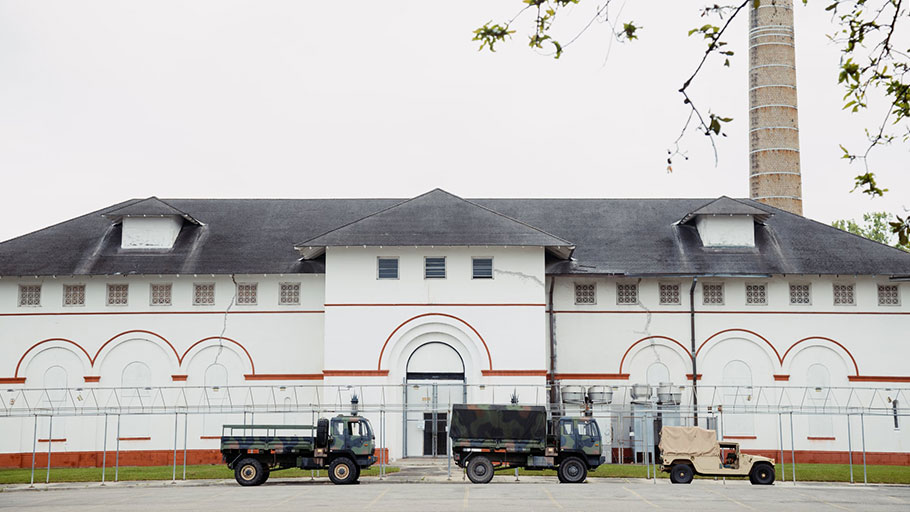
The national guard is helping to manage a Covid-19 testing site in the Treme neighborhood of New Orleans. Photograph: Bryan Tarnowski for the Guardian
In the absence of sufficient test kits, the US Centers of Disease Control and Prevention (CDC) initially kept a tight rein on testing, creating a bottleneck. “I believe the CDC was caught flat-footed,” was how the governor of New York, Andrew Cuomo, put it on 7 March. “They’re slowing down the state.”
The CDC’s botched rollout of testing was the first indication that the Trump administration was faltering as the health emergency gathered pace. Behind the scenes, deep flaws in the way federal agencies had come to operate under Trump were being exposed.
In 2018 the pandemic unit in the national security council – which was tasked to prepare for health emergencies precisely like the current one – was disbanded. “Eliminating the office has contributed to the federal government’s sluggish domestic response,” Beth Cameron, a former senior director of the office, wrote in the Washington Post.
We didn’t use that time optimally, especially in the case of testing. We have been playing reluctant catch-up – William Schaffner
Disbanding the unit exacerbated a trend that was already prevalent after two years of Trump – an exodus of skilled and experienced officials who knew what they were doing. “There’s been an erosion of expertise, of competent leadership, at important levels of government,” a former senior government official told the Guardian.
“Over time there was a lot of paranoia and people left and they had a hard time attracting good replacements,” the official said. “Nobody wanted to work there.”
It was hardly a morale-boosting gesture when Trump proposed a 16% cut in CDC funding on 10 February – 11 days after the World Health Organization had declared a public health emergency over Covid-19.
Schaffner, who describes himself as the “president of the CDC fan club”, said he has been saddened by how sidelined the CDC has become over the past two months. “Here we have the public health issue of our era and one doesn’t hear from the CDC, the premier public health organization in the world,” Schaffner said.
Under Trump, anti-science sweeps through DC
The Food and Drug Administration (FDA), which regulates the diagnostic tests and will control any new treatments for coronavirus, has also shown vulnerabilities. The agency recently indicated that it was looking into the possibility of prescribing the malaria drug chloroquine for coronavirus sufferers, even though there is no evidence it would work and some indication it could have serious side-effects.
The decision dismayed experts, given that Trump has personally pushed the unproven remedy on a whim. It smacked of the wave of anti-science sentiment sweeping federal agencies under this presidency.
As the former senior official put it: “We have the FDA bowing to political pressure and making decisions completely counter to modern science.”
Highly respected career civil servants, with impeccable scientific credentials, have struggled to get out in front of the president. Dr Anthony Fauci, an infectious disease expert who has become a rare trusted face in the administration amid the coronavirus scourge, has expressed his frustration.
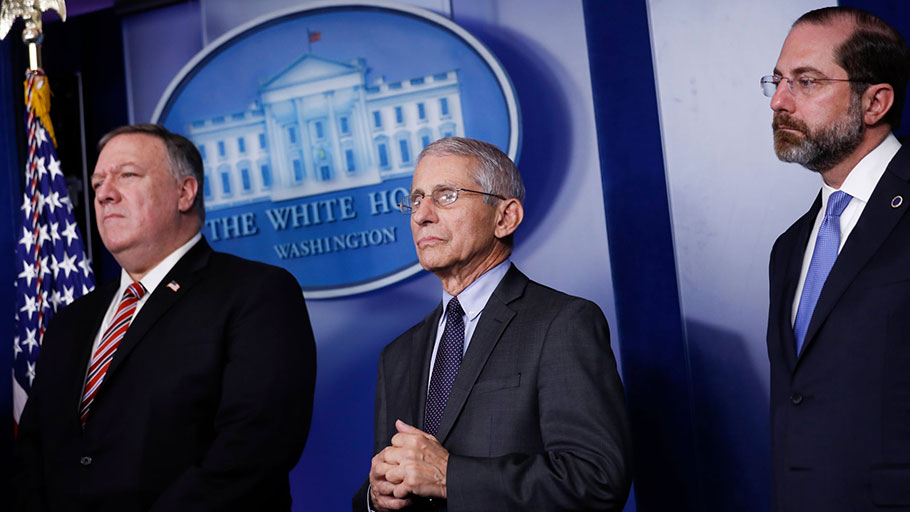
The US secretary of state, Mike Pompeo, with Dr Anthony Fauci and the health secretary, Alex Azar. Photograph: Al Drago/EPA
This week Fauci was asked by a Science magazine writer, Jon Cohen, how he could stand beside Trump at daily press briefings and listen to him misleading the American people with comments such as that the China travel ban had been a great success in blocking entry of the virus. Fauci replied: “I know, but what do you want me to do? I mean, seriously Jon, let’s get real, what do you want me to do?”
Trump has designated himself a “wartime president”. But if the title bears any validity, his military tactics have been highly unconventional. He has exacerbated the problems encountered by federal agencies by playing musical chairs at the top of the coronavirus force.
The president began by creating on 29 January a special coronavirus taskforce, then gave Vice-President Mike Pence the job, who promptly appointed Deborah Birx “coronavirus response coordinator”, before the federal emergency agency Fema began taking charge of key areas, with Jared Kushner, the president’s son-in-law, creating a shadow team that increasingly appears to be calling the shots.
“There’s no point of responsibility,” the former senior official told the Guardian. “It keeps shifting. Nobody owns the problem.”
Trump: everything’s going to be great
Amid the confusion, day-to-day management of the crisis has frequently come directly from Trump himself via his Twitter feed. The president, with more than half an eye on the New York stock exchange, has consistently talked down the scale of the crisis.
On 30 January, as the World Health Organization was declaring a global emergency, Trump said: “We only have five people. Hopefully, everything’s going to be great.”
Video
Trump’s changing reactions to coronavirus: from calm to closing borders – Guardian News
On 24 February, Trump claimed “the coronavirus is very much under control in the USA”. The next day, Nancy Messonnier, the CDC’s top official on respiratory diseases, took the radically different approach of telling the truth, warning the American people that “disruption to everyday life might be severe”.
Trump was reportedly so angered by the comment and its impact on share prices that he shouted down the phone at Messonnier’s boss, the secretary of health and human services, Alex Azar.
“Messonnier was 100% right. She gave a totally honest and accurate assessment,” Konyndyk told the Guardian. And for that, Trump angrily rebuked her department. “That sent a very clear message about what is and isn’t permissible to say.”
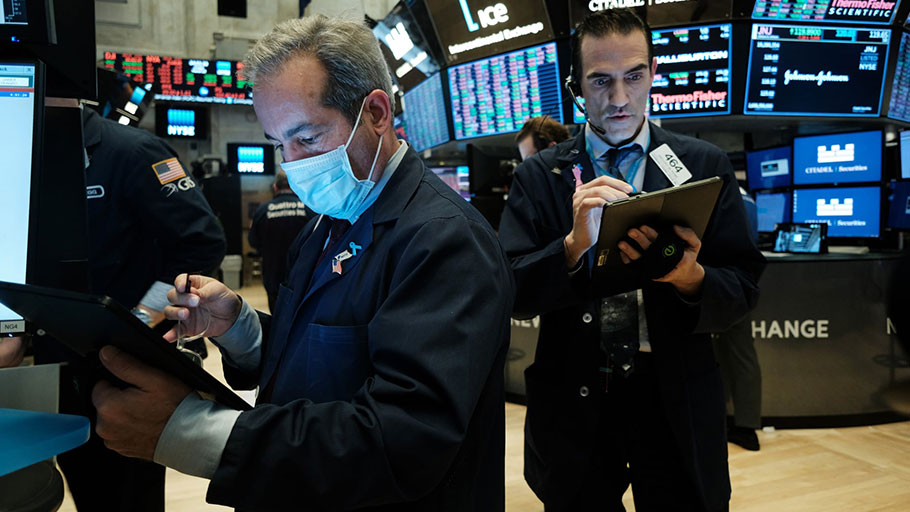
Traders, some in medical masks, work on the floor of the New York stock exchange last week. Traders are now working remotely. Photograph: Spencer Platt/Getty Images
Konyndyk recalls attending a meeting in mid-February with top Trump administration officials present in which the only topic of conversation was the travel bans. That’s when he began to despair about the federal handling of the crisis.
“I thought, ‘Holy Jesus!’ Where’s the discussion on protecting our hospitals? Where’s the discussion on high-risk populations, on surveillance so we can detect where the virus is. I knew then that the president had set the priority, the bureaucracy was following it, but it was the wrong priority.”
So it has transpired. In the wake of the testing disaster has come the personal protective equipment (PPE) disaster, the hospital bed disaster, and now the ventilator disaster.
Ventilators, literal life preservers, are in dire short supply across the country. When governors begged Trump to unleash the full might of the US government on this critical problem, he gave his answer on 16 March.
In a phrase that will stand beside 20 January 2020 as one of the most revelatory moments of the history of coronavirus, he said: “Respirators, ventilators, all of the equipment – try getting it yourselves.”
To date, the Trump administration has supplied 400 ventilators to New York. By Cuomo’s estimation, 30,000 are needed.
“You want a pat on the back for sending 400 ventilators?” Cuomo scathingly asked on Tuesday. He added: “You pick the 26,000 who are going to die because you only sent 400 ventilators.”
‘A total vacuum of federal leadership’
In the absence of a strong federal response, a patchwork of efforts has sprouted all across the country. State governors are doing their own thing. Cities, even individual hospitals, are coping as best they can.
In an improvised attempt to address such inconsistencies, charitable startups have proliferated on social media. Konyndyk has clubbed together with fellow disaster relief experts to set up Covid Local, an online “quick and dirty” guide to how to fight a pandemic.
“We are seeing the emergence of 50-state anarchy, because of a total vacuum of federal leadership. It’s absurd that thinktanks and Twitter are providing more actionable guidance in the US than the federal government, but that’s where we are.”
Valerie Griffeth is a founding member of another of the new online startups that are trying to fill the Trump void. Set up by emergency department doctors across the country, GetUsPPE.org seeks to counter the top-down chaos that is putting frontline health workers like herself in danger through a dearth of protective gear.
Griffeth is an emergency and critical care physician in Portland, Oregon. She spends most days now in intensive care treating perilously ill patients with coronavirus.
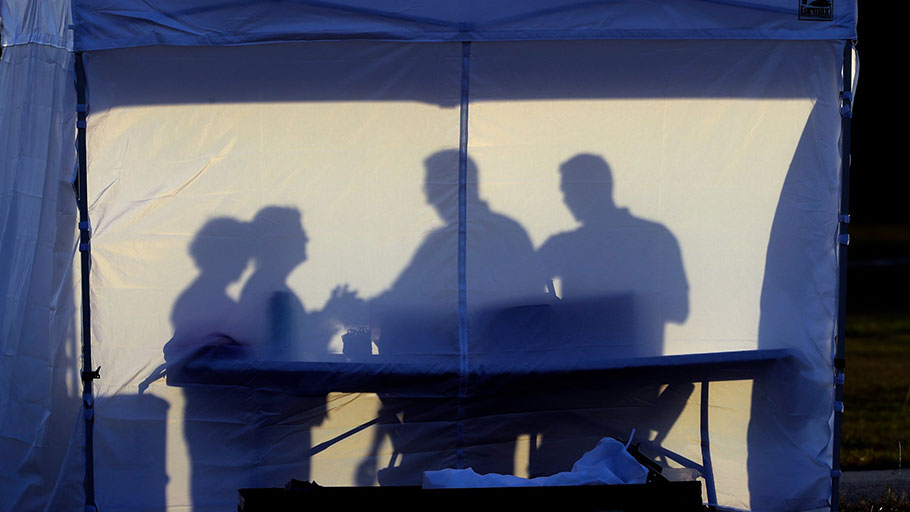
Medical personnel are silhouetted against the back of a tent at a coronavirus test site in Tampa, Florida. Photograph: Chris O’Meara/AP
Her hospital is relatively well supplied, she said, but even so protective masks will run out within two weeks. “We are all worried about it, we’re scared for our own health, the health of our families, of our patients.”
Early on in the crisis, Griffeth said, it dawned on her and many of her peers that the federal government to which they would normally look to keep them safe was nowhere to be seen. They resigned themselves to a terrible new reality.
“We said to ourselves we are going to get exposed to the virus. When the federal government isn’t there to provide adequate supplies, it’s just a matter of time.”
But just in the last few days, Griffeth has started to see the emergence of something else. She has witnessed an explosion of Americans doing it for themselves, filling in the holes left by Trump’s failed leadership.
“People are stepping up all around us,” she said. “I’m amazed by what has happened in such short time. It gives me hope.”
This article was originally published by The Guardian.

